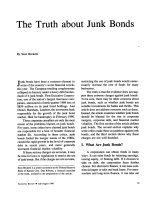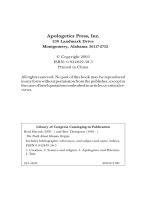4 5 21 the truth about rodents (science)
Bạn đang xem bản rút gọn của tài liệu. Xem và tải ngay bản đầy đủ của tài liệu tại đây (6.07 MB, 18 trang )
The Truth About
Rodents
by Kate Johanns
H O UG H T O N MIF F L IN
The Truth About
Rodents
by Kate Johanns
PHOTOGRAPHY CREDITS: Cover © Arco Images/Alamy; tp © Anthony Bannister/Animals Animals – Earth Scenes — All
rights reserved; 3 © Arco Images/Alamy; 5 © Ethan Meleg/Getty Images; 6 © Larry Lee Photography/Corbis; 7 ©
Anthony Bannister/Animals Animals – Earth Scenes — All rights reserved; 8 © Nicholas Bergkessel, Jr./Photo Researchers,
Inc.; 9 © Tom Lazar/Animals Animals – Earth Scenes — All rights reserved.; 10–11 © Arco Images/Alamy; 13 © Dennie
Cody/Getty Images; 14 © Altrendo Nature/Getty Images.
Copyright © by Houghton Mifflin Company. All rights reserved.
No part of this work may be reproduced or transmitted in any form or by any means, electronic or mechanical, including
photocopying or recording, or by any information storage or retrieval system without the prior written permission of the
copyright owner unless such copying is expressly permitted by federal copyright law. With the exception of nonprofit
transcription into Braille, Houghton Mifflin is not authorized to grant permission for further uses of this work. Permission
must be obtained from the individual copyright owner as identified herein. Address requests for permission to make copies
of Houghton Mifflin material to School Permissions, Houghton Mifflin Company, 222 Berkeley Street, Boston, MA 02116.
Printed in China
ISBN-13: 978-0-547-02327-4
ISBN-10: 0-547-02327-8
1 2 3 4 5 6 7 8 9 RRD 15 14 13 12 11 10 09 08
Table of Contents
The World of Rodents
4
Busy, Busy Beavers
5
The Prickly Porcupine
7
Nothing Nutty About Squirrels
8
Prairie Dog Towns
9
Eek! A Mouse—and a Rat!
10
More Pet Rodents
11
Caring for Your Pet Rodent
12
The Truth About Rodents
13
Glossary
14
When you tell a friend that you’re about to
read a book about rodents, he or she might say,
“Ewww! Rodents are gross!”
However, the world of rodents is actually
very interesting. Once you are familiar with
some of the approximately 1,500 species of
rodents, you’ll find there is a lot to appreciate
about these little mammals.
Gerbils are a type of
rodent kept as a pet.
They grow to be
about 4 inches long.
3
The World of Rodents
Rodents can be found in nearly every type
of habitat, from prairie to forest to desert. Most
rodents are nocturnal, which means that they
are most active at night, and many are scared
of blaring noises. In addition, rodents can grow
anywhere from 4 inches to 4 feet long!
All rodents have a pair of incisors in each
jaw. These teeth continue to grow throughout
their life. The front of an incisor is covered by
an extra layer of hard material. This layer helps
the tooth keep its chisel shape as the rodent
chews on things.
4
Busy, Busy Beavers
The beaver is the largest rodent found in
North America. Most adult beavers weigh
between 40 and 70 pounds. They live in family
groups near rivers, streams, lakes, and marshes.
Beavers have large, nearly
hairless tails that they slap
against the water when
they want to warn others
about a predator. Their
tails can make quite
a racket!
A beaver’s webbed feet
help it swim and work
underwater.
5
Beavers have a thick layer of fat that helps
them stay warm underwater. They make their
fur waterproof by coating themselves with an
oily substance that their bodies make.
Beavers put a lot of effort into building
dome-shaped lodges and dams. Some dams are
as tall as ten feet. Dams offer wetland habitats
for many species, but they can also cause
flooding.
Beavers use mud and sticks to build their dams.
6
The Prickly Porcupine
You probably recognize a porcupine by its
quills, which are hairs with sharp tips on the
ends. The quills are hollow, and they are used
to help porcupines float in water.
The main purpose of quills, however, is
protection. A porcupine can strike a predator
with its tail. Then the quills get stuck in the
predator, and it goes running!
A porcupine may
have as many as
30,000 quills!
7
Nothing Nutty About Squirrels
The rodent we see most often in the wild is
the squirrel. There are more than 200 species
of squirrels, including the Indian giant squirrel,
which grows to be an amazing 3 feet long.
Some types of squirrels are ground, tree,
and flying. Squirrels eat caterpillars and insects
in addition to nuts, leaves,
seeds, and roots.
The flying squirrel
doesn’t really fly. It has a
loose fold of skin between
its arms and legs, which
stretches and helps it glide
from one tree to another.
Flying squirrels can
be found in many
forests across the
United States.
8
Prairie Dog Towns
The prairie dog is a cousin of the ground
squirrel. This very social rodent lives in groups
called prairie dog towns. You’ll find prairie dog
towns on short-grassed prairies in the American
West. Prairie dogs don’t live in areas with long
grass because it would make it difficult for them
to spot predators. Some species of prairie dogs
are considered endangered or threatened.
Unlike most rodents, prairie dogs
are most active during the day.
9
Eek! A Mouse—and a Rat!
Some species of mice and rats are bred to be
pets. Make sure that your pet mouse or
rat comes from a special breeder, pet store, or
rescue group. Never touch a wild mouse or rat.
Pet mice live about two years, and pet rats
live about three years. If you want a pet mouse,
consider what other types of pets you have. Rats,
ferrets, and cats all prey on mice!
Pet rats are very different from rats found in the wild.
10
More Pet Rodents
Hamsters, guinea pigs, gerbils, and chinchillas
also make excellent pets.
• Hamsters love to collect
food and carry it in
special pouches in their
cheeks. They also
perform playful feats on
their exercise wheel.
• Guinea pigs often squeal
A chinchilla’s soft
when their favorite humans
fur makes it a fun
enter the room.
pet.
• Gerbils have poor eyesight,
but their senses of hearing and smell are
highly developed.
11
Caring for Your Pet Rodent
If you choose to adopt a rodent, here are a few
tips for taking care of your new pet:
• Experts suggest that you feed rodents a
combination of seeds, grains, and pellets.
• Rodents need fresh, clean water at all times.
• Remove droppings and uneaten food each day,
and clean the cage every week.
• Promptly return your rodent to his or her
cage after playtime. These pets get lost easily!
• Rodents need lots of exercise, so make sure
your pet has an exercise wheel and can climb
around in the cage.
• Remember always to wash your hands after
handling your rodent.
12
The Truth About Rodents
As you have learned, rodents don’t deserve
their bad reputation. The 1,500 species of
rodents form a group that includes a wide
variety of animals. The next time someone tells
you that rodents are gross,
introduce your friend to
some of the interesting
information you’ve
learned about this
fascinating group
of small mammals.
Rodents can make
great pets.
13
Glossary
Endangered At risk of becoming extinct, or no longer
existing.
Incisor A front tooth used for cutting.
Prairie A large area of flat land covered by grass.
Predator An animal that eats another animal.
The well-known
groundhog is a
rodent too!
14
Responding
Word Builder Many
words have endings added to the end of them.
In the word promptly, -ly is added at the end.
Think of some other words that have -ly added
to the end of them. Copy and complete the
word web below.
TARGET VOCABULARY
promptly
lovely
Words ending
with -ly
?
?
Write About It
Text to Text Write a paragraph about a book
you have read that describes a pet or animal
and how to take care of it. Use two words from
the Word Builder in your paragraph.
15
TARGET VOCABULARY
appreciate
blaring
combination
effort
feats
introduce
nocturnal
promptly
racket
suggest
Summarize Briefly tell the
important parts of the text in your own words.
TARGET STRATEGY
What kind of loud noise does a tennis
player make?
16
Level: R
DRA: 40
Science
Strategy:
Summarize
Word Count: 912
R
4.5.21 Build Vocabulary
HOUGHTON MIFFLIN
Online Leveled Books
ISBN-13:978-0-547-02327-4
ISBN-10:0-547-02327-8
1032228









